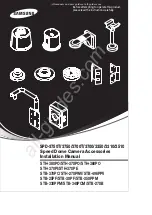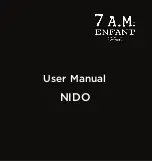
9
Figure 1-10
The three collimation screws are located
on the front of the secondary mirror
housing.
Internal adjustments and cleaning should be done only by the Celestron repair department. If your telescope is in need of internal
cleaning, please call the factory for a return authorization number and price quote.
Collimation
The optical performance of your telescope is directly related to its collimation, that is the alignment of its optical system. Your
telescope was collimated at the factory after it was completely assembled. However, if
the telescope is dropped or jarred severely during transport, it may have to be
collimated. The only optical element that may need to be adjusted, or is possible, is the
tilt of the secondary mirror.
To check the collimation of your telescope you will need a light source. A bright star
near the zenith is ideal since there is a minimal amount of atmospheric distortion. Make
sure that tracking is on so that you won’t have to manually track the star. Or, if you do
not want to power up your telescope, you can use Polaris. Its position relative to the
celestial pole means that it moves very little thus eliminating the need to manually track
it.
Before you begin the collimation process, be sure that your telescope is in thermal
equilibrium with the surroundings. Allow 45 minutes for the telescope to reach
equilibrium if you move it between large temperature extremes.
To verify collimation, view a star near the zenith. Use a medium to high power ocular
— 12mm to 6mm focal length. It is important to center a star in the center of the field
to judge collimation. Slowly cross in and out of focus and judge the symmetry of the star. If you see a systematic skewing of
the star to one side, then re
-
collimation is needed.
To accomplish this, you need to tighten the secondary collimation screw(s) that move the star across the field toward the
direction of the skewed light. These screws are located in the secondary mirror holder (see figure 1-10). Make only small 1/6
to 1/8 adjustments to the collimation screws and re-center the star by moving the scope before making any improvements or
before making further adjustments.
To make collimation a simple procedure, follow these easy steps:
1.
While looking through a medium to high power eyepiece, de-focus a bright star until a ring pattern with a dark shadow
appears (see figure 1-11). Center the de-focused star and notice in which direction the central shadow is skewed.
2.
Place your finger along the edge of the front cell of the telescope (be careful not to touch the corrector plate), pointing
towards the collimation screws. The shadow of your finger should be visible when looking into the eyepiece. Rotate
your finger around the tube edge until its shadow is seen closest to the narrowest portion of the rings (i.e. the same
direction in which the central shadow is skewed).
Figure 1-11 -- Even though the star pattern appears the same on both sides of focus, they are asymmetric. The
dark obstruction is skewed off to the left side of the diffraction pattern indicating poor collimation.






























